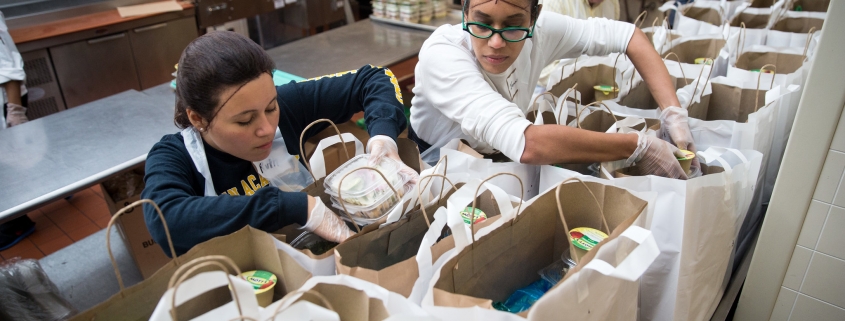If food is medicine , these are the labs
If Food Is Medicine, These Are the Labs
BOSTON — The “food as medicine” philosophy has a simple goal: to control or cure chronic illness by changing what people eat. As the movement gains greater visibility, community meal programs are seeking bigger kitchens to meet demand.
Community Servings is a case in point. Its mission to nourish the sick in the greater Boston began 28 years ago during the AIDS epidemic, when volunteers set up meal deliveries for people suffering from the weight loss called wasting syndrome.
Today, the nonprofit organization has 60 employees and thousands of volunteers who help cook and deliver meals tailored to the dietary needs of clients managing various life-threatening conditions, including diabetes, kidney disease and cancer. And Community Servings is poised to nearly triple its meal production with a $21 million expansion of its headquarters in Jamaica Plain, a Boston neighborhood.
When completed next year, the 31,000-square-foot “food campus” will house a kitchen large enough to prepare as many as 1.5 million meals a year, healthful entrees that these days include quinoa burgers, turkey tender Parmesan and sweet potato lentil soup. The facility will also include a learning kitchen for job training, classrooms for nutrition education and a policy center focused on teaching other groups how to replicate the organization’s model.


Demand for medically tailored meals in the Boston area has grown some 40 percent in the last five years, said David B. Waters, the organization’s chief executive. The wait list for Community Servings is now about 100 people. The vast majority of the group’s clients are in low-income households and have more than one illness.
“These are often people with very complicated nutritional needs, which are difficult for anyone to manage,” Mr. Waters said. “But then you add in poverty, and it’s all the more challenging.”
The ramping up at Community Servings reflects a broader trend among similar organizations also born of the AIDS crisis in other cities. In New York, God’s Love We Deliver completed a $28 million expansion in 2015, moving into six-story headquarters named for Michael Kors, a major patron. (The facility’s bakery is named for the late Joan Rivers, who was a longtime supporter.) And in Philadelphia, the Metropolitan Area Neighborhood Nutrition Alliance, or Manna, moved its operation last year into a bigger space that accommodates a 10,000-square-foot, state-of-the-art kitchen.
“We had maxed out at our last facility,” said Sue Daugherty, Manna’s chief executive. “The freezers were so full we had to duct-tape them closed or they would pop open.”

The growth of these organizations is largely dependent on volunteer efforts and donations, but they are hoping that will change in coming years. A national coalition of “food as medicine” advocates is seeking to get medically tailored meals included in health care coverage, said Jean Terranova, the director of food and health policy at Community Servings.
The coalition has pushed for more research into whether medically tailored diets can make patients feel better and reduce health care costs. State-funded research in California is evaluating the effect of these meals on the health care costs of 1,000 chronically ill people on Medi-Cal, the state’s Medicaid program.
A smaller Massachusetts study, published in April, found that people receiving meals from Community Servings had fewer visits to the emergency room and fewer hospital admissions than a control group. The result was a net 16 percent reduction in health care costs, after meal expenses.
Some local insurers are already aligned with the meal services. Community Servings, for example, has contracts with five local health care providers that reimburse the organization for meals.
“Health plans are beginning to understand that not only is this the right thing to do, it’s very good business,” said Ellen M. Zane, the chief executive emeritus of the Tufts Medical Center and a co-chairwoman of Community Servings’ capital campaign.
The fund-raising campaign at Community Servings has raised $8.3 million toward its $10 million goal. The balance of the construction costs is expected to be financed by the federal New Markets Tax Credit Program, community development lenders and the city.
The opportunity for expansion on the dense city block came about unexpectedly when the owner of an adjacent Montessori school retired and the building became available for purchase, Mr. Waters said.
During construction, the organization is using the existing kitchen to continue to prepare meals for 15 different medical diets. The meals are apportioned in color-coded trays and stored in walk-in freezers until delivery. Each client receives a weekly bag of lunches, dinners and snacks. If the client has children, the whole family receives meals.
“Parents will give their meal away if food is scarce, so if you want to feed the sick parent, you have to feed the whole family,” Mr. Waters said.
Feeding families is also the approach at Healing Meals Community Project, an organization that delivers organic meals to families in the Hartford area who are going through a health crisis. It doubles as a youth development organization, training teenage volunteers to do the cooking.

Since its start less than three years ago, the organization has had to move twice to meet rising demand, said Sarah Leathers, the founder and executive director. After borrowing the kitchen in a pasta shop to get going, organizers quickly discovered they needed more storage and cooling space. So they rented kitchen time at a restaurant in Avon, Conn., for about a year.
This summer, they had to move again, and are now renting the kitchen at Auerfarm, a nonprofit educational farm in Bloomfield, Conn. They have also planted a “nourishing garden” at their new location to supply some of the food for their meals.
“When we started, we thought we would serve the Farmington Valley first and then gradually start to grow,” Ms. Leathers said. “But then the calls started to come in from outside the valley, and it was hard for us to say no. Now, we’re in 42 towns.”
In Philadelphia, Ms. Daugherty and her staff at Manna toured at least 65 locations before deciding to lease and renovate a second-floor space with a freight elevator and a loading dock. Finding an affordable space in Philadelphia’s Center City neighborhood made the hunt especially challenging, but closeness to public transit was paramount for an organization reliant on volunteers, she said.
The location, near the Benjamin Franklin Parkway, a hub of city attractions, has also raised the organization’s profile.
“In our old location, we were on an alleyway behind these dumpsters,” Ms. Daugherty said. “Here, I can’t tell you how many people come in off the street and ask about what we’re doing.”
The 23,000-square-foot space gives Manna the ability to cook and store up to 2.8 million meals a year, and serve up to 2,500 clients a month. The renovation cost just under $5 million, raised through a capital campaign.
One of Manna’s biggest fans is William S. George, the president and chief executive of Health Partners Plans, a nonprofit insurance company owned by medical school hospitals in Philadelphia.


Several years ago, Mr. George decided to test Manna’s meal program with a small group of patients with Type 1 diabetes. He said he was so impressed with the outcome, including reduced costs, that “we opened up the floodgates” and extended the service to patients with other conditions. About 2,400 of the company’s members, most poor and on medical assistance, have now received Manna’s meals.
“I don’t think any other insurer in the country is doing this to the scale we are,” Mr. George said. “It’s not your traditional way of managing care. You need to have the courage to stand up and say you can’t just keep throwing money at these conditions by admitting people to the hospital.”


 No
No
Leave a Reply
Want to join the discussion?Feel free to contribute!